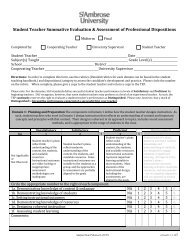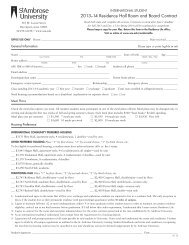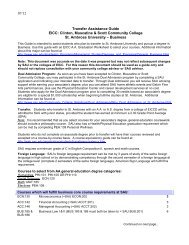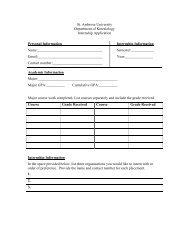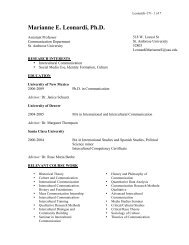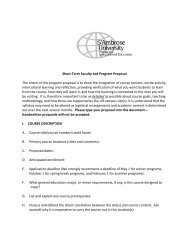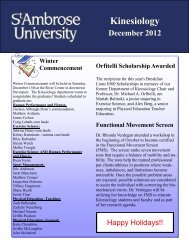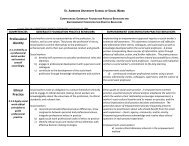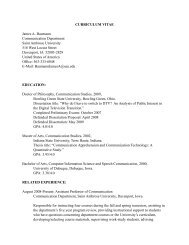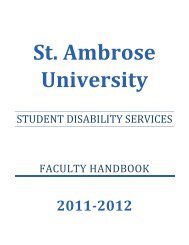St. Ambrose University 518 West Locust Davenport Iowa 52803 admit
St. Ambrose University 518 West Locust Davenport Iowa 52803 admit
St. Ambrose University 518 West Locust Davenport Iowa 52803 admit
You also want an ePaper? Increase the reach of your titles
YUMPU automatically turns print PDFs into web optimized ePapers that Google loves.
Undergraduate Programs<br />
IE 220. Engineering <strong>St</strong>atics<br />
2 credits<br />
Vector and scalar treatment of forces. Resultants,<br />
equilibrium friction, centroids, moments and<br />
products of inertia, external and internal forces.<br />
Applications to pulleys, trusses, frames, beams,<br />
friction. Prerequisite: PHYS 251. (Same as<br />
ENGR 220)<br />
WI-IE 290. Problem-Solving with<br />
Microcomputers<br />
3 credits<br />
Application of microcomputers to solve a variety<br />
of industrial engineering problems. Includes use<br />
of packaged programs as well as designing programs<br />
for specific applications. <strong>St</strong>udents receive<br />
hands-on experience on lab computers and<br />
become familiar with modern industrial engineering<br />
algorithms and problem-solving techniques.<br />
IE 295. Manufacturing Materials<br />
and Processes<br />
3 credits<br />
Fundamentals of manufacturing processes including<br />
founding processes, machining, forming, and<br />
assembly. Characteristics of basic materials<br />
including ferrous and nonferrous metals, plastics,<br />
and other materials. Instruction includes classroom<br />
and field trips.<br />
IE 300. Industrial Engineering Methods 3 credits<br />
Measurement and analysis of work systems.<br />
Ergonomics and the environmental, physical, and<br />
psychological aspects of work. Work measurement<br />
techniques including time study, predetermined<br />
time systems and work sampling.<br />
Classroom and laboratory experiences are utilized<br />
in instruction. Prerequisites: MATH 300,<br />
IE 290.<br />
IE 302. Engineering Dynamics 3 credits<br />
Dynamics and kinematics of particles and rigid<br />
bodies in rectangular, polar, and spherical coordinates.<br />
Work-energy and impulse-momentum<br />
theories for rigid body motion. Oscillations of<br />
particles and systems. Applications to engineering<br />
+ = Applicable toward general education degree requirements<br />
WI = Writing intensive course<br />
systems. Prerequisite: IE 220. (Same as<br />
ENGR 302)<br />
IE 303. <strong>St</strong>rength of Materials<br />
3 credits<br />
Plane stress, plane strain, stress-strain relationship,<br />
and elements of material behavior. Elements<br />
of stress and deformation analysis applied to<br />
members subject to centric, torsional, flexural<br />
and combined loadings. Elementary considerations<br />
of theories of failure, buckling, repeated<br />
and impact loads. Prerequisite: IE 220. (Same as<br />
ENGR 303)<br />
IE 304. Design Fundamentals<br />
for Industrial Engineers<br />
3 credits<br />
Introduction to the process of engineering design.<br />
Application of this process via student projects<br />
which are related to industrial engineering functional<br />
areas. Prerequisites: Completion of four IE<br />
courses.<br />
IE 310. Materials Science<br />
3 credits<br />
Crystal structure and mineralogy, imperfections<br />
and bondings in solids, relation of structure to<br />
properties. Mechanical, electrical, and thermal<br />
behavior of materials. Mechanisms of deformation<br />
and transformation. Prerequisites:<br />
CHEM 103 or 105, PHYS 251. (Same as<br />
ENGR 310)<br />
IE 312. Thermodynamics<br />
3 credits<br />
Introduction to classical and quantum statistics;<br />
thermodynamic laws, energy, entropy and equilibria,<br />
cyclic and noncyclic processes; applications<br />
to chemical and engineering problems.<br />
Prerequisites: PHYS 253, MATH 280. (Same as<br />
PHYS 321 and ENGR 312)<br />
IE 315. Engineering Economy<br />
3 credits<br />
Evaluation of private and public sector project<br />
alternatives in quantitative and qualitative terms.<br />
Cost/benefit analysis. Time value of money and<br />
application of this concept to evaluation of economic<br />
feasibility and alternatives, including payback,<br />
present value, and return on investment.<br />
Prerequisite: MATH 191.<br />
108




